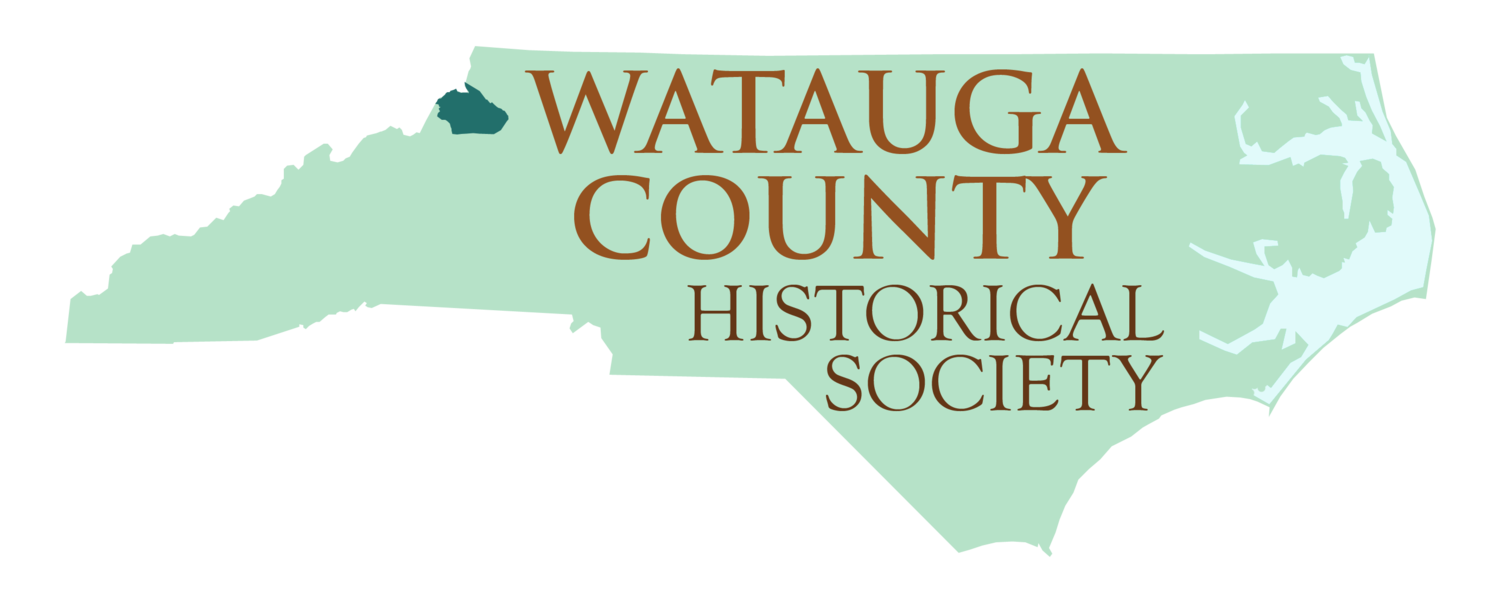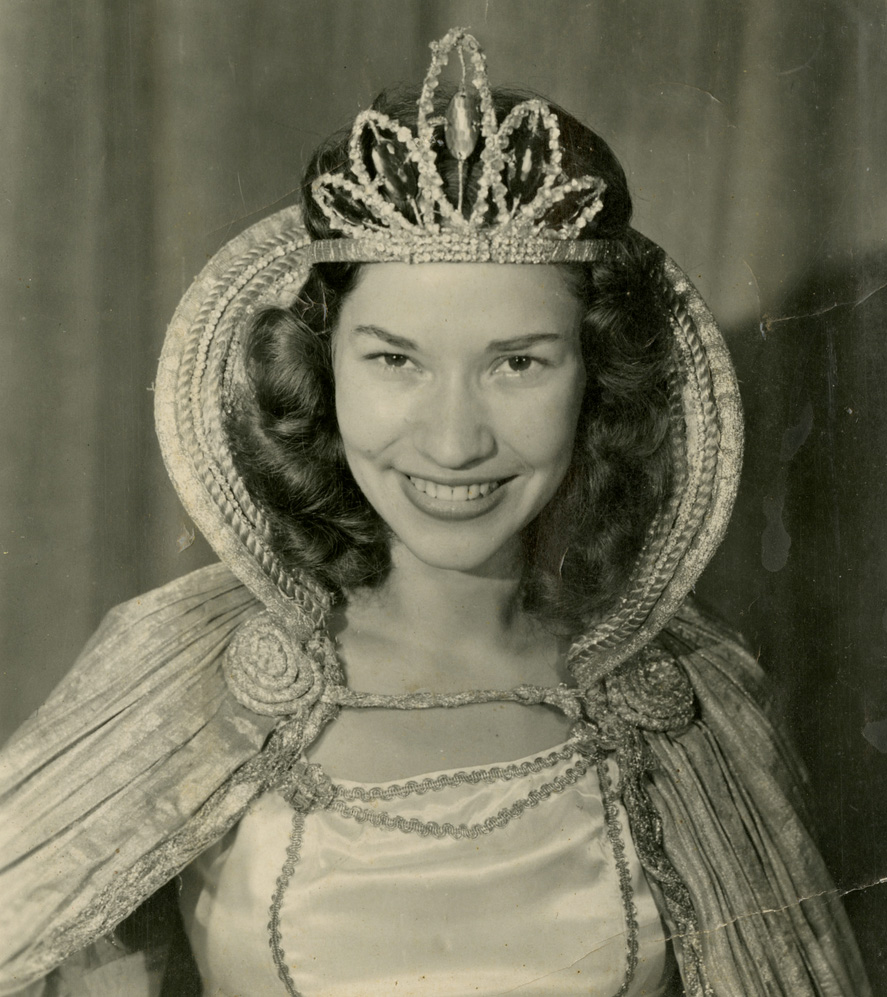By Ashley Parker, Digital Watauga Intern
Each semester, Digital Watauga asks its interns to select some aspect of a collection on which the intern has worked to explore in greater detail for a blog post. Our intern for Fall 2017, Ashley Parker, worked on three collections: 1) processing and archival re-housing of the forthcoming Paul Armfield Coffey Collection, 2) scanning, metadata entry, and uploading of Box 6 of the Palmer Blair Collection (now online), and 3) scanning, metadata entry, and uploading of the Von and Mickey Hagaman Collection (now online).
Costumed participants (and a chicken!) from the 1949 Watauga County Centennial posed for this image by local photographer Palmer Blair. Mickey McGuire is at far left with a pumpkin on her knee. Image courtesy of the Digital Watauga Project, Von and Mickey Hagaman Collection (Von-Hag-1-020).
Nestled in the Appalachian Mountains of North Carolina, Watauga County is a place known for its extraordinary landscapes and rich history. Before European colonization, the indigenous Cherokee nation inhabited the area that became Watauga County. The word “Watauga” itself is taken from the Watauga River, a Cherokee word that has a range of theorized translations including “beautiful waters” and “river of plenty.”[1] During the mid to late eighteenth century early American pioneers began exploring and settling the Appalachians. Among these early pioneers was the famous Daniel Boone, who allegedly camped with some frequency in the vicinity of Watauga’s county seat of Boone, lending his name to the town.[2] The county itself would not be formed until 1849 from the southern portion of Ashe County as well as parts of Caldwell, Wilkes and Yancey counties, and Boone did not incorporate until 1872.[3]
In 1949 Watauga County reached a major milestone in its history—the 100 year anniversary of its founding. That year county leaders led by Stanley Harris, President of Watauga Centennial Inc., organized a massive six-day Centennial celebration.[4] The festivities began on July 5 and lasted until July 10, with each day being themed: Governor’s Day, Pioneer Day, Education Day, Youth Day, Farmer’s Day, and Worship Day.[5] Within this schedule, centennial events included a parade, contests for “Queen of the Centennial” and “Watauga Pioneer,” as well as a historical pageant on the history of Watauga County titled Echoes of the Blue Ridge. This production included twelve vignette, each telling the story of a different period of Watauga history, including a dance representing the natural formation of the area before human settlement and entries addressing the history of the Cherokee and their interactions with the De Soto expedition, Daniel Boone’s hunting cabin in Boone, the formation of the county, and the establishment of the Appalachian State Teacher’s College. The pageant concluded with the entire cast joining together onstage for a “Grand Finale” that symbolized optimism for the future.[6]
Woody Richardson donned this recreation of a Civil War military uniform as part of the 1949 Watauga County Centennial festivities. Image courtesy of the Digital Watauga Project, Von and Mickey Hagaman Collection (Von-Hag-1-013).
One important part of the Centennial celebration was the Queen of the Centennial contest. About seventeen ladies from the county were nominated for the title by various organizations sponsoring the Centennial. When spectators purchased tickets to the events, they were allowed to select their choice for Queen. Votes for Queen were determined by the number of tickets sold in the candidate’s name. Among the candidates was Mickey McGuire, nominated by the Chamber of Commerce. McGuire was very popular and well known throughout town because of her job at the Boone Drug Company on King Street. By the end of voting, McGuire held over 96,500 votes, winning the contest.[7] McGuire was crowned on the Centennial’s opening night, wearing a dress made for her by Mrs. Ethel Teems, who also worked at the Boone Drug Company. As part of her Queenly duties, McGuire gave the opening speech for the celebration, welcoming all of the spectators and visitors to the week-long festivities.[8]
Mickey McGuire posed in her Queen of the Centennial costume for Palmer Blair, a local photographer who shot many of the commemorative photos of the 1949 Watauga County Centennial. Image courtesy of the Digital Watauga Project, Von and Mickey Hagaman Collection (Von-Hag-1-001).
The entire event featured impressive attendance by people from all over Watauga County coming together to celebrate their history. According to Mickey McGuire Hagaman, Queen of the Centennial, nearly everybody in the county participated; even people from outside the county came to take part in the celebrations.[9] Participants dressed in costumes related to the history of the Appalachians. People who marched in the parade dressed as pioneers driving wagon trains, Native Americans, and Confederate soldiers. Many men who participated grew nineteenth century-styled beards in preparation for their costumed appearances. In addition to costumed participants the parade included various floats from local organizations, marching bands, and a color guard.[10] The color guard was made up of servicemen from all branches of the military, including Von Hagaman, who was in the Navy. Von Hagaman married Mickey McGuire about a year after the Centennial ended.
Local photographer Palmer Blair also shot this image of the 1949 Watauga County Centennial Parade color guard marching down West King Street from west to east. Von Hagaman is visible as the second man from the right. The 1875 Watauga County Courthouse with its unusual corner entrance on the first floor is visible at right in the distance. Image courtesy of the Digital Watauga Project, Von and Mickey Hagaman Collection (Von-Hag-1-030).
Due to the overwhelming popularity of the Centennial celebration, community leaders realized how important celebrating history could be for bringing communities together and drawing in tourists. They decided to put on the Echoes of the Blue Ridge pageant again the next year to continue celebrating the history of the county. Echoes of the Blue Ridge ran for two years until 1952, when playwright Kermit Hunter was hired to write a new drama on the history of the county and surrounding area.[11] Hunter was already well known for his work on other popular outdoor historical dramas in the Appalachians, including Honey in the Rock, a Civil War musical drama in West Virginia, and Unto These Hills, a history of the Eastern Band of Cherokee performed in Cherokee, North Carolina. The drama Hunter wrote in 1952 was titled Horn in the West and told the story of Western North Carolina’s involvement in the Revolutionary War. This summer Horn in the West celebrated its 66th consecutive season and is the oldest Revolutionary War outdoor drama in the country. Horn in the West continues to draw tourists from all over the country to Boone each summer to celebrate the history of Western North Carolina.
Many of the images contained in the Von and Mickey Hagaman Collection document this pivotal, centennial event in the history of Watauga County. The Digital Watauga Project is grateful to Rosemary Virginia, the daughter of Von and Mickey Hagaman, for her generosity in making these images available to the project.
NOTES
[1] Allan Scherlen, "What In The World Is Watauga?," Mountain Times 38, (April 27, 2000), http://libres.uncg.edu/ir/asu/f/Scherlen_Allan_2000Apr_what_in_the_world.pdf.
[2] “”Camped Here 1760-69” Newspaper Clipping,” Digital Watauga, accessed December 5, 2017, http://digitalwatauga.org/items/show/5822.
[3] Daniel Jay Whitener, History of Watauga County: A Souvenir of Watauga Centennial (Boone, North Carolina, 1949), https://babel.hathitrust.org/cgi/pt?id=uva.x001317192;view=1up;seq=60, page 33.
[4] “Watauga County, North Carolina Centennial Papers”, W.L. Eury Appalachian Collection, Appalachian State University, Boone, North Carolina,http://www.collections.library.appstate.edu/findingaids/ac642.
[5] Whitener, History of Watauga County, 55.
[6] Whitener, History of Watauga County, 57.
[7] Watauga Democrat, “"Rev. Gragg is Pioneer; Mickey McGuire is Queen" Newspaper Article,” Digital Watauga, accessed December 5, 2017, http://digitalwatauga.org/items/show/5816.
[8] Whitener, History of Watauga County, 56.
[9] Mickey Hagaman, interview by Ashley Parker, December 4, 2017.
[10] Palmer Blair, “Palmer Blair Movie Collection #3: 1949 Watauga Centennial Parade, Part 1,” Digital Watauga, accessed December 5, 2017, http://digitalwatauga.org/items/show/5846.
[11] “'Horn in the West' opens Friday, opening night discount for Watauga residents”, Watauga Democrat, June 20, 2017, http://www.wataugademocrat.com/community/horn-in-the-west-opens-friday-opening-night-discount-for/article_d196fc34-9d13-57ac-9bc1-37cf96de0237.html.




